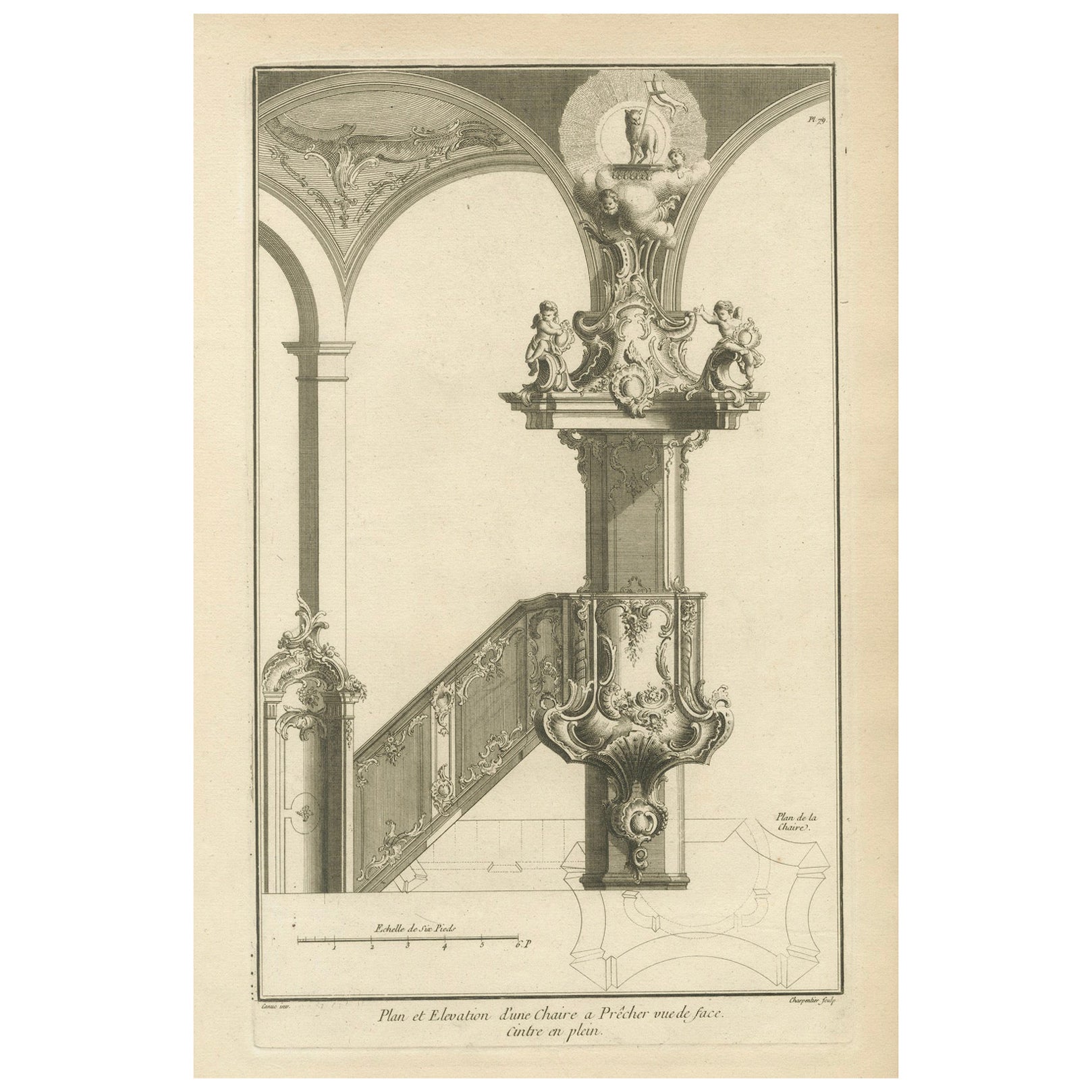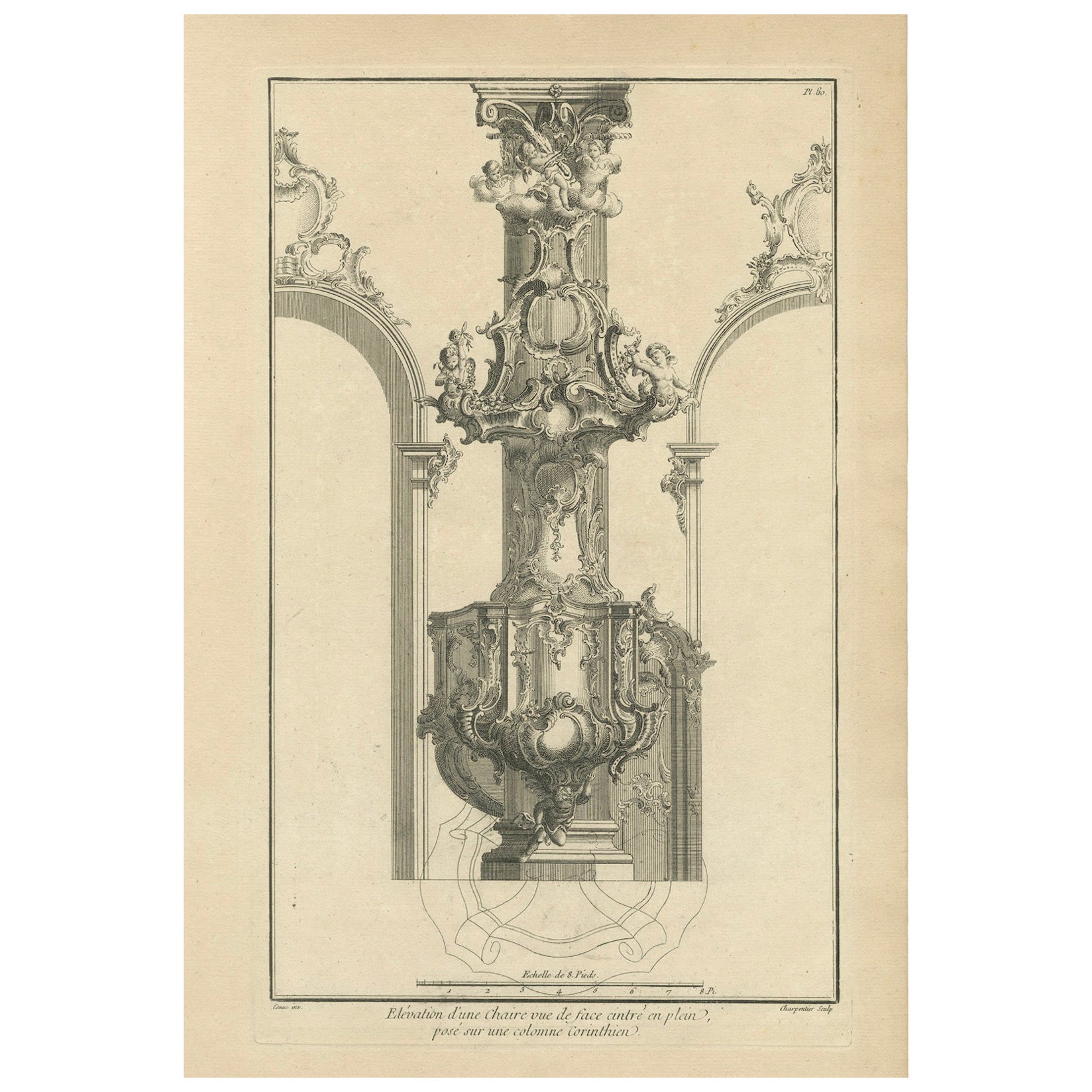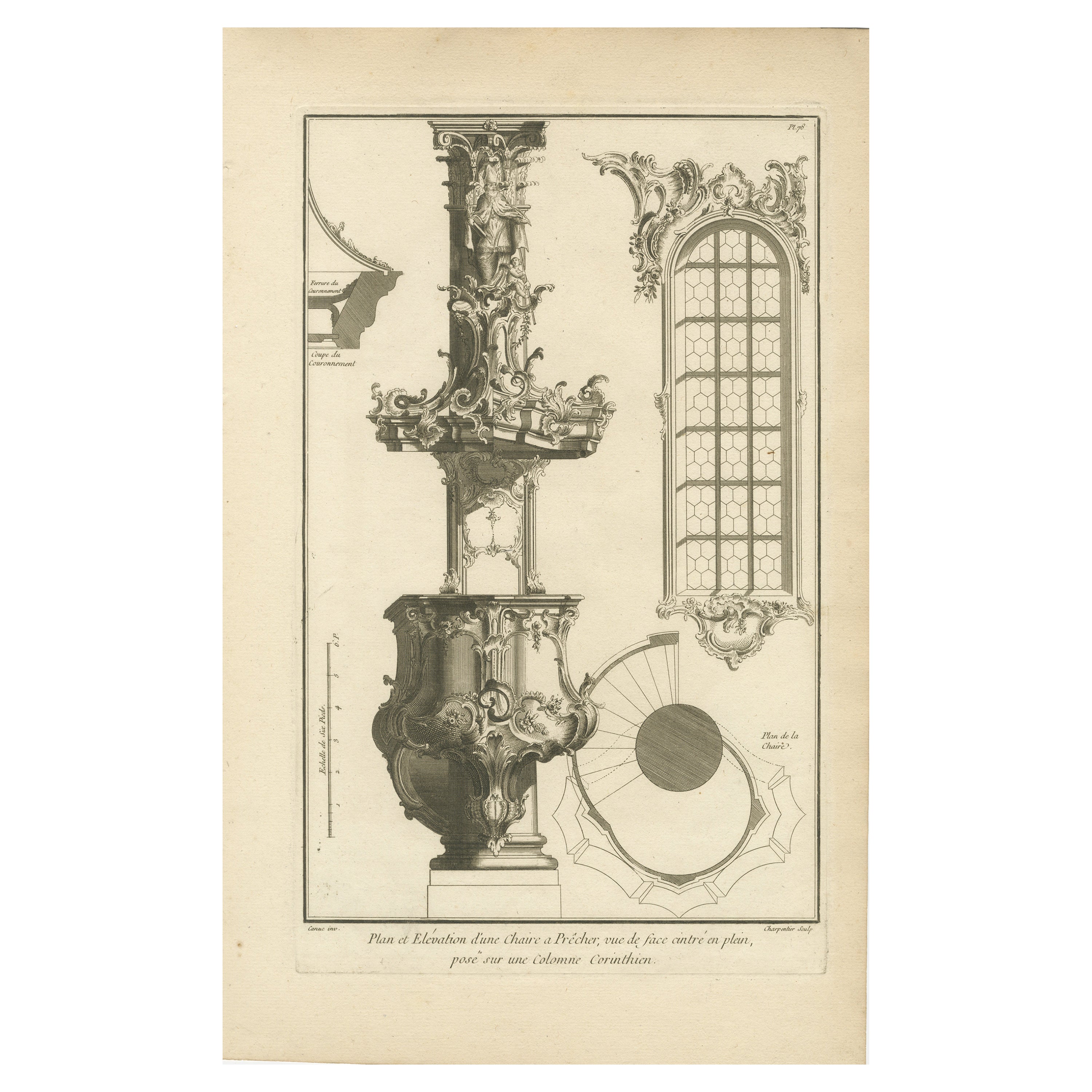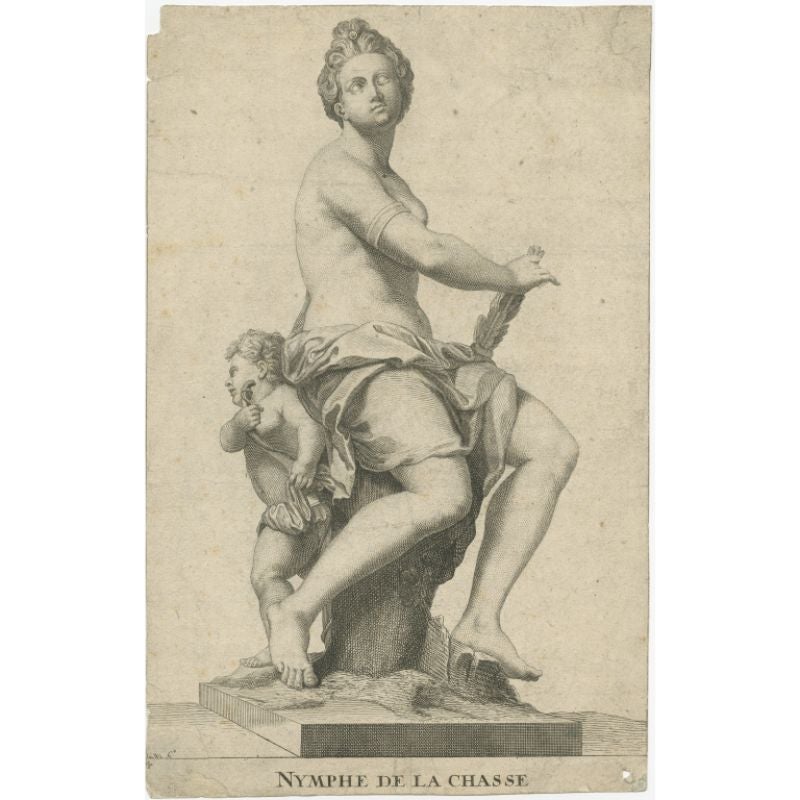Items Similar to Original Antique Baroque Sermon Pulpit with Full Arch Elevation, circa 1740
Want more images or videos?
Request additional images or videos from the seller
1 of 6
Original Antique Baroque Sermon Pulpit with Full Arch Elevation, circa 1740
About the Item
This is an original antique architectural design for a pulpit in baroque style dating approximately between 1740 and 1760.
The artist responsible for this design is Franz Xaver Habermann, and it was published by Johann Georg Hertel I in Augsburg. The design shows a richly decorated pulpit, typical of the Rococo style, which is known for its elaborate ornamentation, asymmetry, and curves. This image is one of four numbered plates related to this work. The detail in the engraving is meticulous, showcasing the elaborate aesthetic that characterized much of the European art and architecture during the mid-18th century.
Franz Xaver Habermann (1721–1796) was a German engraver and etcher who was active during the 18th century, a period marked by the Rococo style. Although not as widely known as some of his contemporaries, Habermann contributed significantly to the graphic arts during his time.
Habermann's work often featured architectural designs, such as the intricate pulpit depicted in the image you've provided. He was skilled in creating prints that detailed elaborate decorative schemes and architectural fantasies, which were popular during the Rococo period. His creations were known for their intricate details and the fluidity of their lines, capturing the lightness and ornamental excesses that characterized Rococo design.
Johann Georg Hertel I, who published Habermann's work, was part of a notable family of engravers and publishers in Augsburg, a city that was an important center for publishing in Europe at the time. The Hertel family played a significant role in disseminating artistic and architectural designs through their publications.
While specific details about Habermann’s life and training may not be as well-documented as those of major artists of his time, his surviving works suggest that he was a highly skilled engraver who had mastered the Rococo style, contributing to the spread of this aesthetic through his printed works. His designs would have influenced the tastes of the period, both within Germany and across Europe, where the appetite for such elaborate designs was significant.
More in detail about this engraving:
The print showcases a highly ornate pulpit in the Baroque style, viewed from the side angle. It is an architectural engraving, displaying the design in great detail. The pulpit is characterized by elaborate scrollwork, organic motifs, and dramatic curves, which are hallmarks of the Baroque period.
At the top of the pulpit, there is a decorative canopy, which includes a sculptural relief, possibly of religious significance, and is topped with what appears to be a figure of an angel. This figure adds a sense of verticality and grandeur to the structure, as it seems to watch over the proceedings from above.
The body of the pulpit itself is rich with decorative elements, including ornamental panels and a dynamic arrangement of curves and counter-curves. The pulpit is supported by a structure that includes a column or pedestal at the base, detailed with similar ornate patterns and motifs that resonate with the upper portions.
The drawing includes a side panel that might indicate the context in which the pulpit is set, suggesting the interior of a church with walls and possibly seating. Additionally, there is a ground plan to the lower part of the image, providing a bird's-eye view of the pulpit's footprint, which further aids in visualizing the spatial arrangement and the relation of the pulpit to its surroundings.
Overall, the print is a fine representation of Baroque ecclesiastical design, emphasizing drama, luxury, and movement through its complex decorative language. The craftsmanship of the engraving is meticulous, capturing the opulence and intricate designs that would have been carved into the wood or stone of the actual pulpit.
Note from seller: In our shop we also published the other three engravings in this series and they might still be on offer as well.
- Dimensions:Height: 16.54 in (42 cm)Width: 10.44 in (26.5 cm)Depth: 0 in (0.02 mm)
- Materials and Techniques:Paper,Engraved
- Period:1740-1749
- Date of Manufacture:circa 1740
- Condition:Good, given age. Light soiling near paper edges. Light staining. Left paper edges a bit rough from binding. Very light creasing from handling. General age-related toning and/or occasional minor defects from handling. Please study scan carefully.
- Seller Location:Langweer, NL
- Reference Number:
About the Seller
5.0
Platinum Seller
These expertly vetted sellers are 1stDibs' most experienced sellers and are rated highest by our customers.
Established in 2009
1stDibs seller since 2017
1,970 sales on 1stDibs
Typical response time: <1 hour
- ShippingRetrieving quote...Ships From: Langweer, Netherlands
- Return PolicyA return for this item may be initiated within 14 days of delivery.
More From This SellerView All
- Baroque Pulpit Elevation with Ornate Archway and Balustrade Engraved, ca.1740Located in Langweer, NLThis is an original antique architectural design for a pulpit in baroque style with archway and balustrade dating approximately between 1740 and 1760. The artist responsible for th...Category
Antique 1740s Prints
MaterialsPaper
- Architectural Print of a Rococo Pulpit Elevation on a Corinthian Column, ca.1740Located in Langweer, NLThis is an original antique architectural design for a rococo pulpit dating approximately between 1740 and 1760. The artist responsible for this design is Franz Xaver Habermann, an...Category
Antique 1740s Prints
MaterialsPaper
- Old Baroque Pulpit Design with Corinthian Column and Staircase Plan, ca.1740Located in Langweer, NLArchitectural design with the central elements depicted in the engraving: the Baroque design of the pulpit, the inclusion of a Corinthian column which suggests a classical influence, and the presence of a staircase plan indicating the approach to the pulpit. Dating approximately between 1740 and 1760. The artist responsible for this design is Franz Xaver Habermann, and it was published by Johann Georg Hertel I in Augsburg. The design shows a richly decorated pulpit and archway, typical of the Rococo style, which is known for its elaborate ornamentation, asymmetry, and curves. This image is one of four numbered plates related to this work. The detail in the engraving is meticulous, showcasing the elaborate aesthetic that characterized much of the European art and architecture during the mid-18th century. Franz Xaver Habermann (1721–1796) was a German engraver and etcher who was active during the 18th century, a period marked by the Rococo style. Although not as widely known as some of his contemporaries, Habermann contributed significantly to the graphic arts during his time. Habermann's work often featured architectural designs, such as the intricate pulpit depicted in the image you've provided. He was skilled in creating prints that detailed elaborate decorative schemes and architectural fantasies, which were popular during the Rococo period. His creations were known for their intricate details and the fluidity of their lines, capturing the lightness and ornamental excesses that characterized Rococo design. Johann Georg Hertel I, who published Habermann's work, was part of a notable family of engravers and publishers in Augsburg, a city that was an important center for publishing in Europe at the time. The Hertel family played a significant role in disseminating artistic and architectural designs through their publications. While specific details about Habermann’s life and training may not be as well-documented as those of major artists of his time, his surviving works suggest that he was a highly skilled engraver who had mastered the Rococo style, contributing to the spread of this aesthetic through his printed works. His designs would have influenced the tastes of the period, both within Germany and across Europe, where the appetite for such elaborate designs was significant. More in detail about this engraving: This engraving features a detailed representation of a Baroque-style preacher's pulpit, intricately designed and placed upon a Corinthian column, demonstrating the grandeur of religious architecture during the Baroque period. The pulpit is richly adorned with elaborate scrollwork, acanthus leaves, and possibly religious iconography, all common elements in Baroque ecclesiastical design. A significant feature of this print is the inclusion of architectural details such as the Corinthian column base, known for its ornate capital with acanthus leaves and scrolls, which supports the pulpit above. This classical element signifies stability and order, providing a stark contrast to the exuberant decoration of the pulpit itself. To the right of the pulpit, there's a tall, slender window filled with panes that could either be clear or stained glass, framed by an ornate window arch...Category
Antique 1740s Prints
MaterialsPaper
- Original Antique Engraving of a Hunting Nymph, c.1740Located in Langweer, NLAntique print titled 'Nymphe de la Chasse'. Old print of a sculpture of Jardin des Tuileries (Tuileries Garden), Paris. It shows a hunting nymph. Source unknown, to be determined. ...Category
Antique 18th Century Prints
MaterialsPaper
- Antique Portrait of Louis of France, circa 1740Located in Langweer, NLAntique portrait titled 'Ludovicus Galliae Delphinus'. Portrait of Louis of France. He was the eldest son and heir of Louis XIV, King of France, and ...Category
Antique 18th Century Prints
MaterialsPaper
- Antique Map of Germany by Hederichs 'circa 1740'Located in Langweer, NLAntique map titled 'Germania'. Rare miniature map of Germany and surroundings. This map covers the entirety of those lands traditionally occupied by Germanic peoples, from the Blatic...Category
Antique Mid-18th Century Maps
MaterialsPaper
You May Also Like
- Original Antique Print of Moths, circa 1850Located in St Annes, LancashireGreat print of moths Lithograph Original hand colour Published, circa 1850 Unframed.Category
Antique 1850s English Victorian Prints
MaterialsPaper
- Original Antique Print of A Hippopotamus, circa 1850Located in St Annes, LancashireGreat print of a hippopotamus Lithograph Original hand colour Published, circa 1850 Unframed.Category
Antique 1850s English Victorian Prints
MaterialsPaper
- Original Antique Print of A Greyhound, circa 1850Located in St Annes, LancashireGreat print of a greyhound Lithograph Original hand colour Published, circa 1850 Unframed.Category
Antique 1850s English Victorian Prints
MaterialsPaper
- Original Antique Print of A Giraffe, circa 1850Located in St Annes, LancashireGreat print of a giraffe Lithograph Original hand colour Published, circa 1850 Unframed.Category
Antique 1850s English Victorian Prints
MaterialsPaper
- Original Antique Equestrian Portrait Print, circa 1800Located in St Annes, LancashireWonderful print of a Yeoman of The Guard Copper-plate engraving after N.C Goodnight Published circa 1800 Unframed.Category
Antique Early 1800s English Elizabethan Prints
MaterialsPaper
- Original Antique Print of Parrots, circa 1850, 'Unframed'Located in St Annes, LancashireGreat image of parrots. Unframed. It gives you the option of perhaps making a set up using your own choice of frames. Lithograph after cpt. Brown with original hand color. Publish...Category
Antique 1840s English Folk Art Prints
MaterialsPaper
Recently Viewed
View AllMore Ways To Browse
European Carved Wood Relief
Mid Century Carved Wall Panel
Antique German Watch
Antique Counter Display
Antique Display Counter
Carved Stone Arch
Church Arch
Carved Wood Religious Figure
Antique Wood Angel
Carved Fantasy
Arched Canopy
Antique Shop Counter
Antique Shop Counters
Wood Relief Religious
Antique Pedestal Architectural Wood
Pedestal Stone Display
Rococo Wall Panel
Religious Wall Relief





